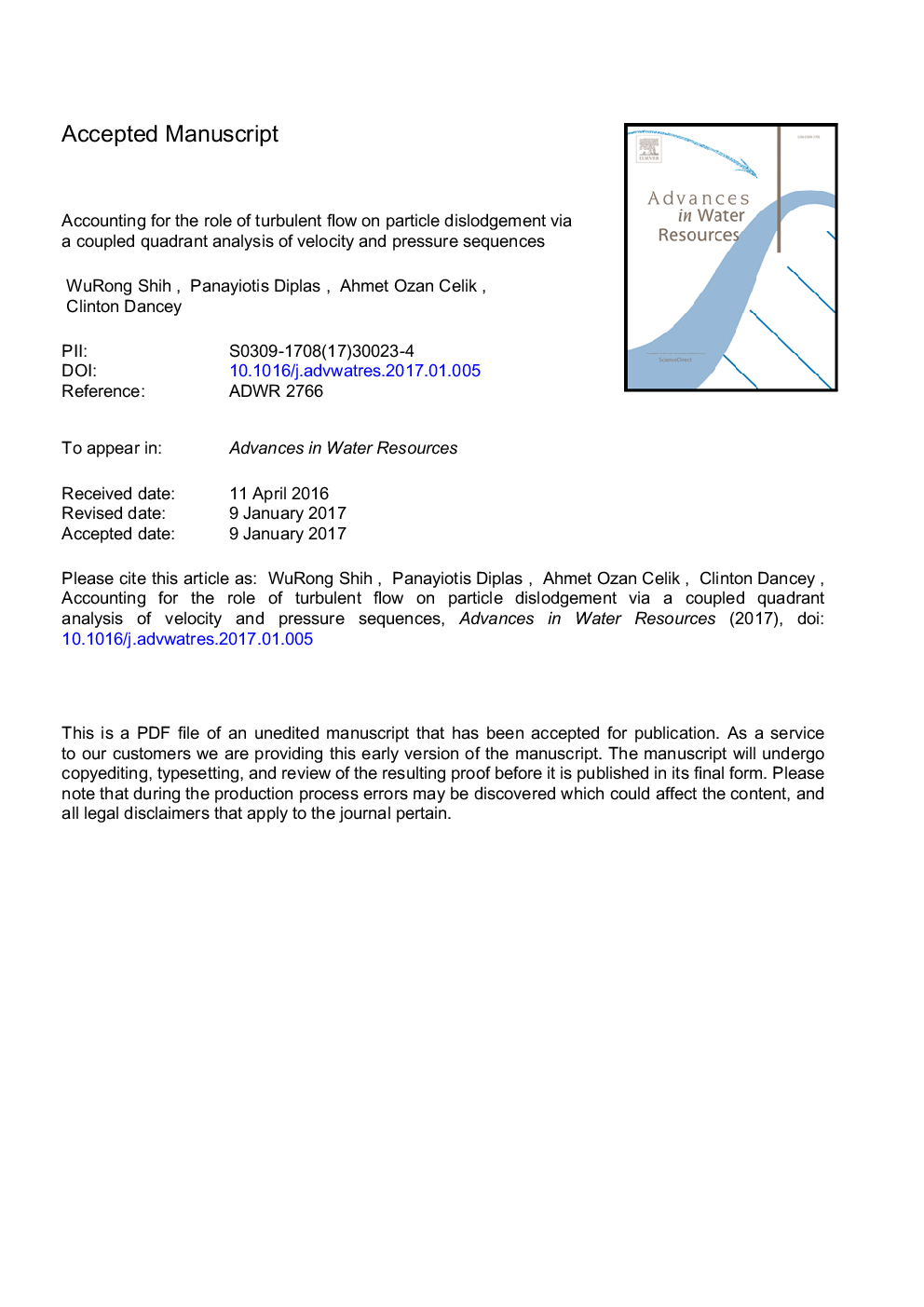| کد مقاله | کد نشریه | سال انتشار | مقاله انگلیسی | نسخه تمام متن |
|---|---|---|---|---|
| 5763845 | 1625610 | 2017 | 31 صفحه PDF | دانلود رایگان |
عنوان انگلیسی مقاله ISI
Accounting for the role of turbulent flow on particle dislodgement via a coupled quadrant analysis of velocity and pressure sequences
ترجمه فارسی عنوان
حسابداری برای نقش جریان آشفته در تخریب ذرات از طریق تجزیه و تحلیل مسطح همراه با توالی سرعت و فشار
دانلود مقاله + سفارش ترجمه
دانلود مقاله ISI انگلیسی
رایگان برای ایرانیان
کلمات کلیدی
آغاز حرکت ذرات، ساختار منسجم، معیار ضربه
ترجمه چکیده
مطالعات اخیر نشان داده است که اهمیت زمان، علاوه بر قدر، وقایع آشفته پر انرژی در تخریب ذرات تحت آستانه شرایط حرکت است. بنابراین در اینجا پیشنهاد شده است که استفاده از توالی های آشفتگی، به جای یک رویداد افراطی لحظه ای، مناسب تر برای توصیف نقش سرعت های نوسان و نیروهای هیدرودینامیکی مربوط به تحرک ذرات است. اعتبار روش پیشنهادی از طریق تجزیه و تحلیل دقیق مجموعه داده های اندازه گیری سرعت و فشار مستقیما مورد بررسی قرار می گیرد. در تلاش برای ارتباط نتایج حاصل از تجزیه و تحلیل مسطح مرسوم سرعت با اندازه گیری فشار لحظه ای، مفهوم تحلیل ربع فشار معرفی شده است. توالی های دوگانه ای از سرعت های همزمان و فشارهای ربع فشار به شرح کامل تر از ویژگی های جریان شتابان محلی، از جمله ساختارهای منسجم شایع و تفسیر روشنی از نقش آنها در تحرک ذرات می پردازند. در اینجا نتیجه می گیریم که ساختارهای جابجایی در مقیاس بزرگ قادر به ایجاد نوسانات نیروی بیش از حد و پایدار هستند که عمدتا مسئول فرآیند پویایی ناپیوسته ذرات هستند. این نتیجه، معیار ضربه را به عنوان روش مناسب برای حسابداری برای اثر تجمعی ساختارهای یکپارچه بر جنبش ذرات حمایت می کند.
موضوعات مرتبط
مهندسی و علوم پایه
علوم زمین و سیارات
فرآیندهای سطح زمین
چکیده انگلیسی
Recent studies have demonstrated the importance of duration, in addition to magnitude, of energetic turbulent events on particle dislodgement under threshold of motion conditions. It is therefore proposed here that the use of turbulence sequences, instead of single instantaneous extreme events, is more appropriate for characterizing the role of fluctuating velocities and associated hydrodynamic forces on particle mobility. The validity of the proposed method is examined through the detailed analysis of directly measured velocity and pressure data sets. In an effort to relate the results of the conventional velocity quadrant analysis with the instantaneous pressure measurements, the concept of pressure quadrant analysis is introduced. The coupled sequences of the synchronous velocity and pressure quadrant events allow for a more complete description of the local turbulent flow characteristics, including the prevalent coherent structures, and more clear interpretation of their role on particle mobility. It is concluded here that large-scale sweep structures are capable of generating excessive and persistent force fluctuations which are predominantly responsible for the dynamic process of particle dislodgement. This result supports the impulse criterion as the proper way of accounting for the cumulative effect of coherent structures on particle movement.
ناشر
Database: Elsevier - ScienceDirect (ساینس دایرکت)
Journal: Advances in Water Resources - Volume 101, March 2017, Pages 37-48
Journal: Advances in Water Resources - Volume 101, March 2017, Pages 37-48
نویسندگان
WuRong Shih, Panayiotis Diplas, Ahmet Ozan Celik, Clinton Dancey,
